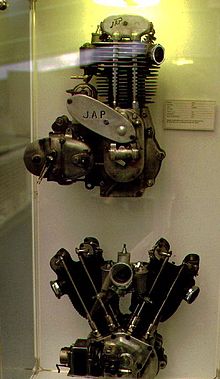YES
| JA Prestwich Industries | |
|---|---|
| legal form | Limited Company |
| founding | 1895 |
| Seat |
London United Kingdom |

JAP was a Tottenham company founded by John Alfred Prestwich and first noticed for the cameras he made . In the 1920s and 1930s, JAP was one of the largest suppliers of built-in motors in Europe.
description
JAP began manufacturing complete motorcycles around 1904, but motorcycle production was given up in 1908 in favor of engine production and engine development. Famous brands that purchased JAP engines before the First World War included BAT, Chater-Lea , Martin, Matchless , Sunbeam , Trump , Triumph , Zenith , but also Morgan , a manufacturer of three-wheelers at the time . After 1918, the Brough Superior company contributed to the continued popularity of these engines. As early as the beginning of the 1920s, JAP supplied powerful engines in almost all displacement classes. From the late 1920s, JAP engines were widely used across Europe and America.
Many motorcycle manufacturers who couldn't afford to build their own engines built in JAP engines. In addition, special motors with a displacement of up to 1400 cm³ (V2) were manufactured, for example for draisines .
In racing, many manufacturers put their trust in the 250, 350, 500 and 1000 engines, but JAP also built 175, 200, 300, 680, 750, etc. in various designs: with side valves, with overhead valves, with automatic inlet valves and in the middle of the 1920s overhead cam engines . A 1000 V2-Racing-JAP operated with ethanol could produce over 100 HP. For record purposes, these engines were in the 1930s with compressors charged.
The heyday for JAP was over by 1932/1933. On the one hand, many motorcycle manufacturers had to close their doors due to the global economic crisis , on the other hand, the German market almost completely collapsed due to import restrictions and, last but not least, many "survivors" of the global economic crisis now built their own engines. The market for special engines remained for JAP, for example for sand and grass track races. This sport was still dominated by JAP until the 1960s and afterwards JAP-based engines were still running. However, the company was taken over by the Birmingham engine manufacturer Villiers Ltd in 1945 . From 1957 it only built industrial engines.
Among other things, the racing driver Heinz Melkus successfully drove in the 1950s Formula 3 races with a JAP engine that he built himself. The single-cylinder four-stroke engine had a displacement of 498 cm³ and made 45-47 hp.
Number key
At least the engines that were built from 1920 onwards can be broken down using the letter codes stamped on the crankcase . The first letter stands for bore × stroke and the resulting displacement:
- Z = 175 cm³ (55 × 73 mm)
- V = 175 cm³ (60 × 62 mm)
- N = 200 cm³ (55 × 83 mm)
- P = 250 cm³ (62.5 × 80 mm)
- B = 250 cm³ (64.5 × 76 mm)
- A = 300 cm³ (70 × 78 mm)
- F = 300 cm³ (70 × 76 mm)
- G = 350 cm³ (70 × 88 mm)
- I = 350 cm³ (70 × 90 mm)
- S = 350 cm³ (74 × 80 mm)
- E = 375 cm³ (74 × 85 mm)
- M = 300 cm³ (70 × 97 mm)
- J = 500 cm³ (80 × 99 mm)
- K = 500 cm³ (85.5 × 85 mm)
- L = 550 cm³ (85.5 × 97 mm)
- U = 600 cm³ (85.5 × 104 mm)
A “T” for twin would now follow for a two-cylinder.
- GT = 680 cm³
- MT = 750 cc
- KT and JT = 1000 cm³
Now the letters for the respective versions follow:
- O = OHV control (hanging valves / overhead valves)
- W = water cooling
- S = short stroke or special motor
- R = racing engine
- Z = dry sump lubrication
- C = sports engine
- Y = double exhaust / double port cylinder head
These letters were also combined. Now follows a slash and then the year of construction is given according to the following letters:
The word PNEUMATICS began in 1920 with the letter "P" and ended in 1929 with "S". W = 1930, H = 1931, Y = 1932, Z = 1933, D = 1934, R = 1935, V = 1936, F = 1937, O = 1938, G = 1939
This is followed by the serial number.
A KTOYZ / I 22312 would then be, for example, a 1000 V2 with overhead valves, double port cylinder heads and dry sump lubrication from 1927.
Automobile production
Between 1904 and 1905 the company also manufactured automobiles . These were tricycles with a single rear wheel. The engine with 593 cm³ displacement and 4.5 HP was mounted in the front of the vehicle. The open body offered space for two people next to each other.
literature
- Harald H. Linz, Halwart Schrader : The International Automobile Encyclopedia . United Soft Media Verlag, Munich 2008, ISBN 978-3-8032-9876-8 .
Web links
- JA Prestwich Industries (JAP )
- Brief History of the Marque: JAP (English)
- http://www.500race.org/Marques/JAP.htm
Individual evidence
- ↑ Elizabeth Pears: Tottenham's favorite engineering son is remembered. In: Tottenham & Wood Green Independent. Newsquest Media Group, March 25, 2010, accessed January 6, 2018 .
- ^ JA Prestwich Industries. In: Grace's Guide to British Industrial History. Grace's Guide Ltd., accessed January 6, 2018 .
- ↑ Harald H. Linz, Halwart Schrader : The International Automobile Encyclopedia . United Soft Media Verlag, Munich 2008, ISBN 978-3-8032-9876-8 .
